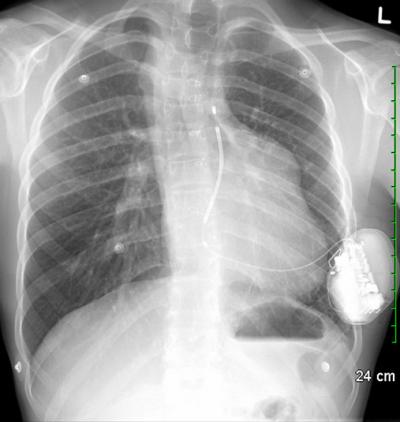A new ground-breaking technology was recently used at the University of Ottawa Heart Institute (UOHI) where two cardiologists, Dr. David Birnie and Dr. Pablo Nery, implanted a new innovative leadless defibrillator, the subcutaneous implantable cardioverter defibrillator (S-ICD), to a 18 year-old patient. Under Health Canada‘s special access program, this was only the third time this new type of ICD had been implanted in Canada.
Conventional defibrillators, known as transvenous defibrillators, are implanted with wires, called the leads, that snake through veins into the heart. When the defibrillator identifies any dangerous heartbeat, it delivers a shock through the wires to return the heart to its normal rhythm and allow it to get back to pumping blood steadily throughout the body.
This is a preview of Leadless Defibrillator: Groundbreaking Biomedical Research.
Read the full post (603 words, 5 images, estimated 2:25 mins reading time)

Image via Wikipedia
In the past decade, the use of MRI scanners has skyrocketed. Because the machines are able to provide relatively detailed images of soft tissues, they are extremely valuable in diagnosing cancers, heart problems and even back pain. These machines use a powerful magnetic field, radio frequency pulses and a computer to produce pictures of internal body structures.
But MRIs have been off limits to patients with implanted heart pacemakers. That’s because the MRI’s magnetic field could wreak havoc on a pacemaker’s electronic circuitry. Or worse, some of the pacemaker’s metal components could heat up and literally cook parts of the heart.
This is a preview of Pacing your Heart inside MRI Machine using REVO to be costly.
Read the full post (565 words, 2 images, estimated 2:16 mins reading time)
Artificial Heart Science – This episode spotlights biomedical engineer Richard Smith, CCE, MSEE, the director of the Artificial Heart Program at University Medical Center (UMC) in Tucson, Ariz. When Smith went to college, biomedical engineers weren’t part of the operating room team. However, his background in science and math got him into the operating room in 1985, when he helped implant the first Total Artificial Heart used as a bridge-to-transplant. Today, it is the only FDA, Health Canada and CE approved temporary Total Artificial Heart in the world. There have been more 790 implants, and surgical teams look to Smith to be the expert on the Total Artificial Heart and other heart devices.
This is a preview of Artificial Heart Engineer- A new Job Prospect in Biomedical Engineering.
Read the full post (166 words, 1 image, estimated 40 secs reading time)


